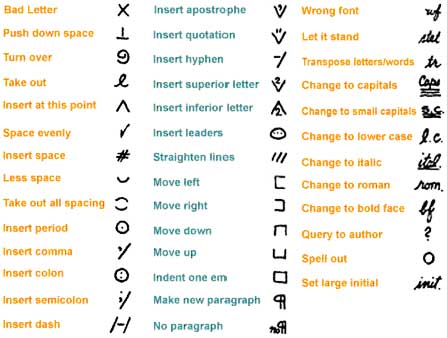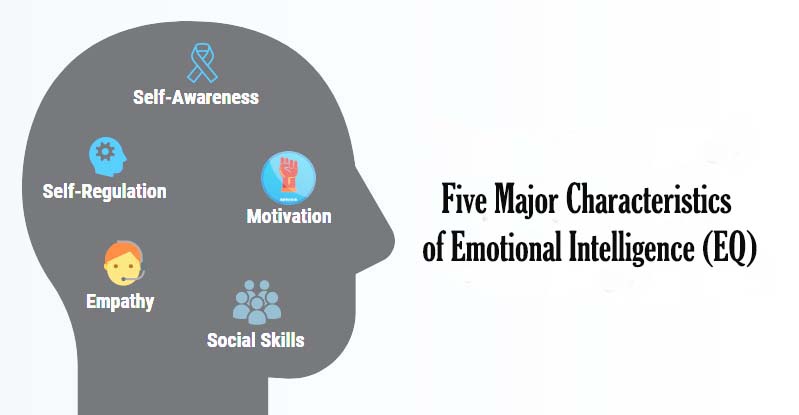Proofreading Symbols: Editing Symbols in Journalism. What is Proofreading? Difference Between Proofreading and Editing. Proofreading Steps, Tips & Process. Do’s and Don’ts of Proofreading.
Proofreading Symbols
Proofreading symbols are the marks that a proofreader makes on a paper when they edit it. They are a coded set of instructions that point out where mistakes have been made and how a piece of writing can be improved.
Proofreading, or ‘copy checking,’ originally referred to newspapers, where an editor would take typeset paper and check the text for errors against an original manuscript. These days, even in newspapers and magazines, which often have their sub-editors proof on-screen, it’s all done digitally.
Proofreading is a surface-level check and final check on a document. A proofreader will look for misspellings, incorrect/missed punctuation, inconsistencies (textual and numerical), etc. On the other hand, editing corrects issues at the core of writing like sentence construction and language clarity. Although editing will help improve the readability, transparency, and tone of the text. An editor will scrutinize and polish your writing for a smooth narration.
Proofreading Steps
Proofreading Steps and Process
The steps of proofreading refer to a set of instructions that proofreaders need to follow thoroughly. The proofreading steps are essential to check the errors of an original manuscript.
Don’t Rely On Spelling and Grammar Checkers.
Spell checkers are great as the first port of call and will help assist you to identify high-level errors. However, automated spelling and grammar checkers are severely inadequate, and they cannot identify many common grammatical errors. Furthermore, they often make serious mistakes that can mislead even the most diligent writer.
Proofread For One Error at a Time
Proofreading really is a meticulous and time-consuming process, but the more you put into it, the more you get out. If you attempt to identify and correct all errors within one sitting, you risk losing focus, and you may find that you miss significant mistakes. Sometimes it’s helpful to check for spelling mistakes and punctuation errors separately. This will make it easier to spot issues, and you can vary the proofreading technique you use on each pass to suit the type of mistakes you are searching for.
Read Each Word Slowly
One technique that the majority of professional proofreaders use is to read the writing they are proofreading out loud. This forces you to voice every single word and involves your auditory senses in the process, meaning that you can hear how the text actually sounds when it is read. Trying to read something quickly forces your brain to skip some words and make unconscious corrections.
Break the Text Into Manageable Chunks
Breaking the text into separate sections provides you with more manageable tasks. Read each section carefully, and then take a break before you progress to the next. This will prevent you from feeling overwhelmed by the task ahead and allow you to concentrate more effectively on the writing section you are proofreading. This technique is especially useful if you are proofreading a very large document, such as a thesis or dissertation.
Circle Punctuation Marks
This method may seem over the top, but it is one of the most effective methods out there for spotting punctuation mistakes. By circling every single punctuation mark, you force yourself to look at each one in turn and question if it has been used correctly.
Read the Writing Backward
This proofreading method helps identify spelling mistakes because it forces you to concentrate on each word in isolation. Start with the last word in your text and follow each one separately until you reach the beginning of the document. While doing this, you are not interested in punctuation and grammar; you focus entirely on how the words have been spelled. Many proofreaders also recommend reading papers backward, sentence by sentence.
Note the Errors You Make Frequently
Proofreading writing regularly can help you identify your strengths and weaknesses and understand where you make mistakes. If you are aware of the common errors you make, you can learn to look for them during the writing process itself and will learn to avoid them altogether over time. Keep style guides and grammar rules to hand as you proofread, and look up any areas you are uncertain about. Over time, you will develop your knowledge, and your writing skills will improve.
What is Proofreading?
Proofreading is the reading of a galley proof or an electronic copy of a publication to find and correct production errors of text or art. Proofreading is the final step in the editorial cycle.
Difference Between Proofreading and Editing
Proofreading and editing are almost similar, but they are very different parts of any publishing process. They also ought to be very different parts of the draft writing process. Proofreading should be done at the end of the writing process, as the final writing stage before the draft is ready.
Editing must be done earlier to perfect the document in advance. Editing deals with basic language usage and communication. Editors will look at word choice, whether or not a document uses too much passive voice. They also check whether or not they have used too many words in general. Editing is concerned with improving the writing content in a way that relates to the text quality, not just its presentation.
The Purpose of Proofreading Symbols
1. For better or worse, people tend to dismiss the value of almost any piece of writing based on a few spelling errors or other minor surface language errors.
2. It is also essential to proofread because poorly checked writing would be harder to read. Well-read people are going to learn by word recognition.
The Process of Proofreading a Paper
First, you will need to take note of all the errors you should fix. Otherwise, you might end up proofreading for spelling errors but not for punctuation errors. Start picking every sentence apart once you have familiarized yourself with everything you should do during the proofreading process. Look for the potential surface language errors that might be there. While reading in each sentence, check the spelling, punctuation, and grammatical errors as well as typing mistakes.
When the paper or piece of writing is proofread the first time, read through it a second time. Just use the same proofreading process. People who have missed a few errors should manage to find them during the second reading. Depending upon the nature of the situation and the importance of the writing, it might be a good idea to do a third reading.
Proofreading & Editing Symbols in Journalism

Proofreading Tips
Tip 1. It is important not to rely on spell-checkers entirely. Some of them might misdiagnose words as misspelled due to the dictionary’s limitations. Some of them might not pick up on misused words.
Tip 2. Certain words are more likely to be mistyped than others based on the position of the letters on the keyboard. For instance, the word ‘the’ is often typed in as “teh” for people who are typing quickly. It would help if you remembered which words these are to scrutinize them more carefully when writing.
Tip 3. People who are prone to misspell certain words should keep in mind which words these are. You might want to avoid using them altogether. Otherwise, just keep your eyes on these words.
Tip 4. Getting a rhythm going is an essential part of proofreading. And it is not the most exciting writing task that is out there. People who try to view the task mechanically will be that much more likely to get through it.
Do’s and Don’ts of Proofreading
• Do repeat the proofreading process more than once.
Don’t proofread during the writing and editing process.
• Do look for grammatical errors, typing errors, spelling errors, and punctuation errors.
Don’t proofread only certain sections of the document to the exclusion of others.
• Do pay attention to words that are frequently mistyped, misspelled, or misused.
Don’t spend too much time on the proofreading process.
